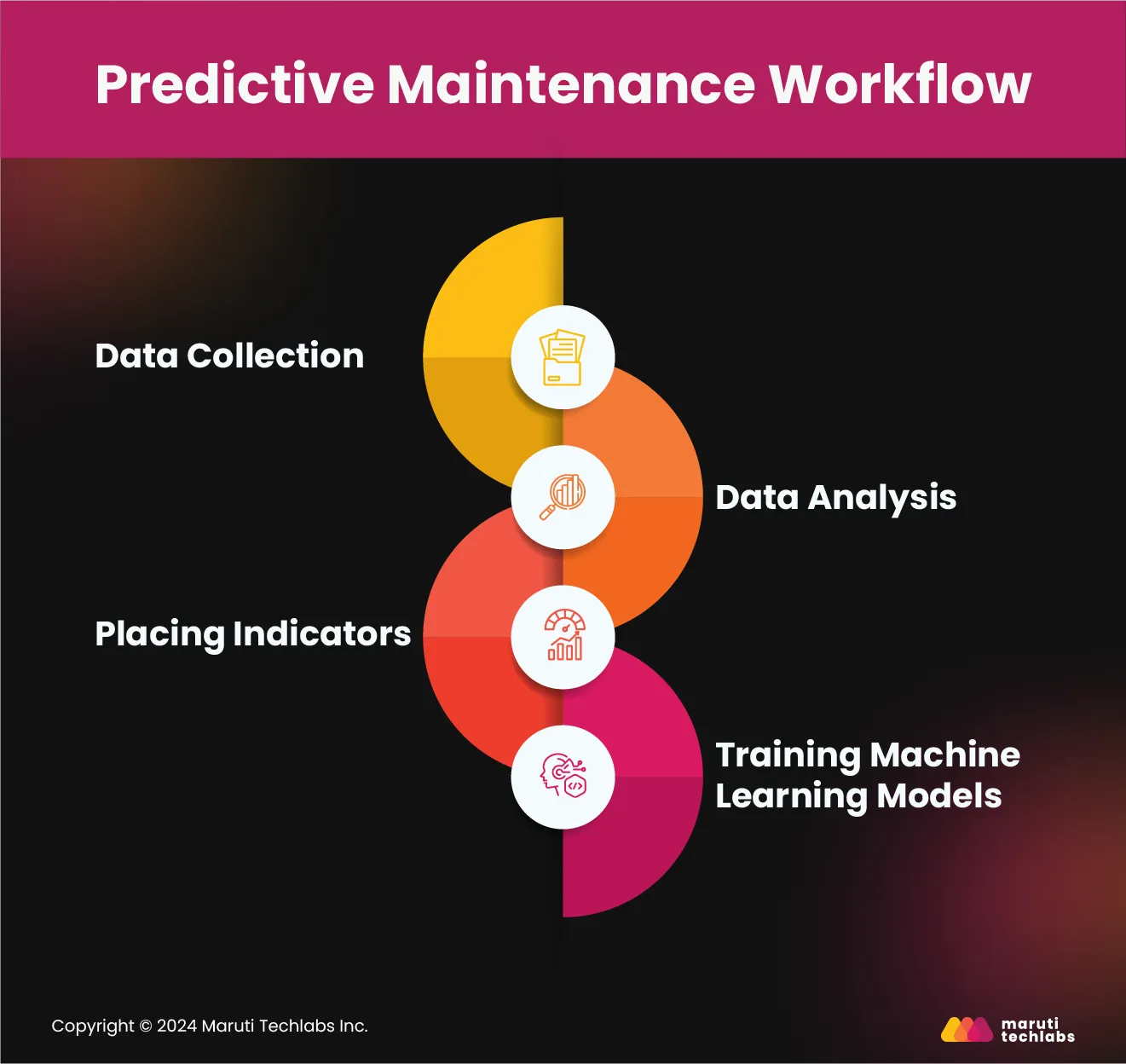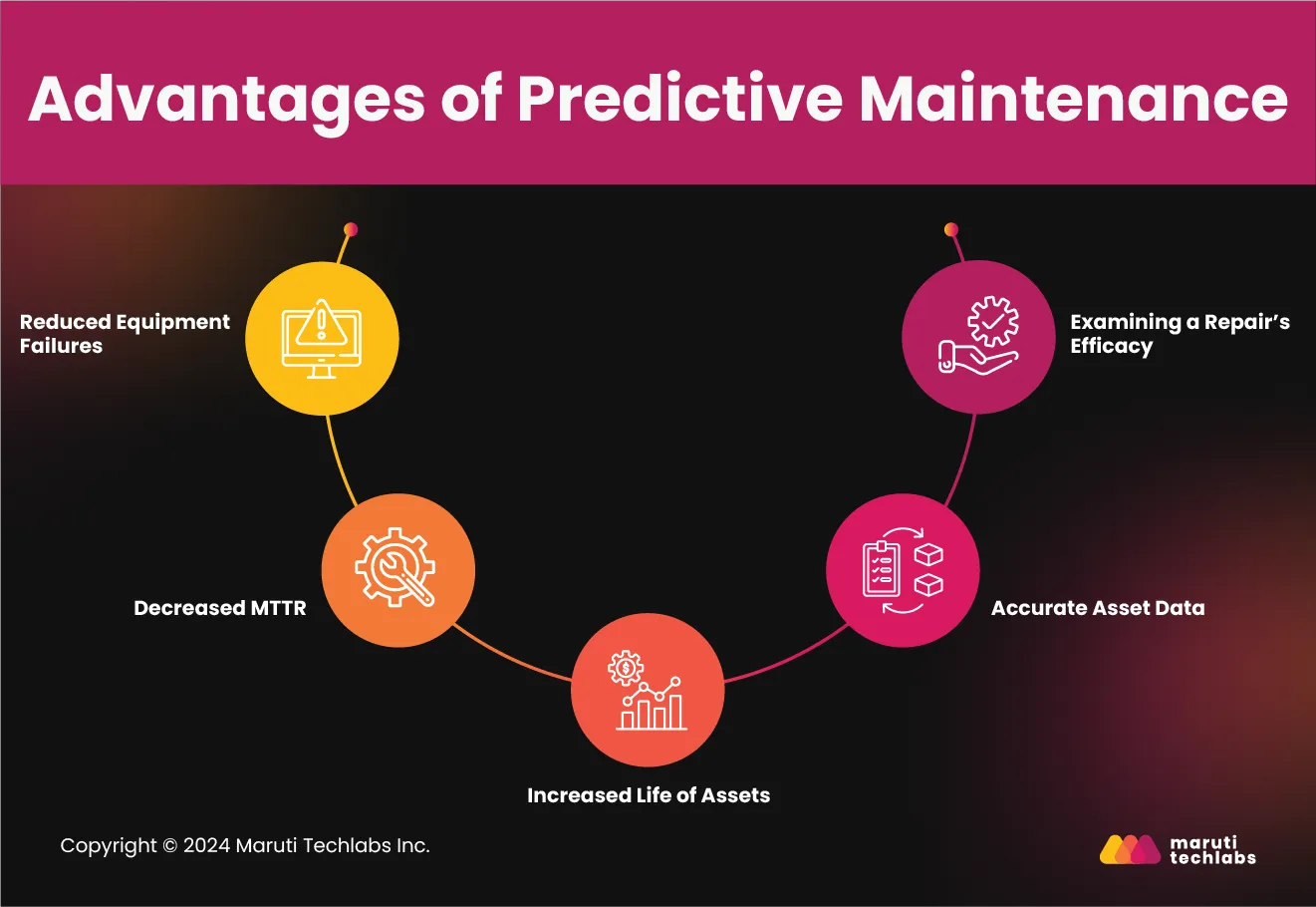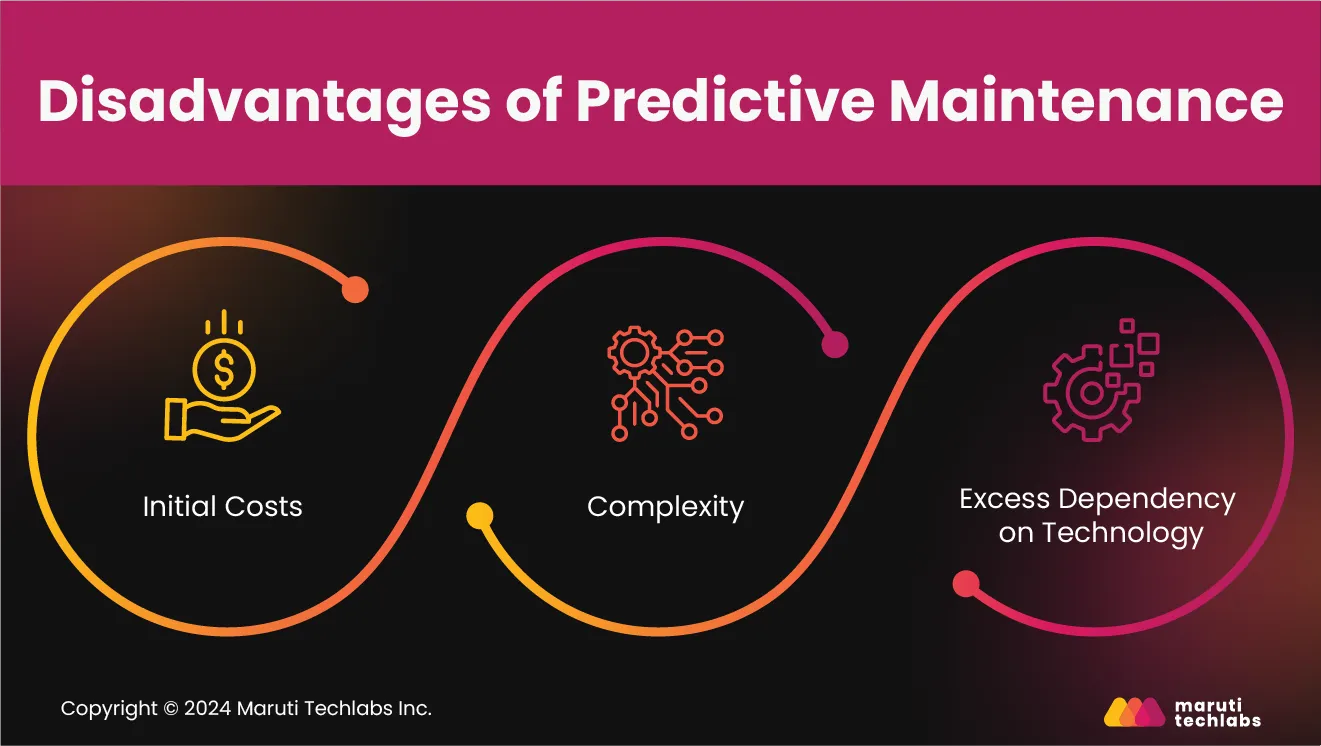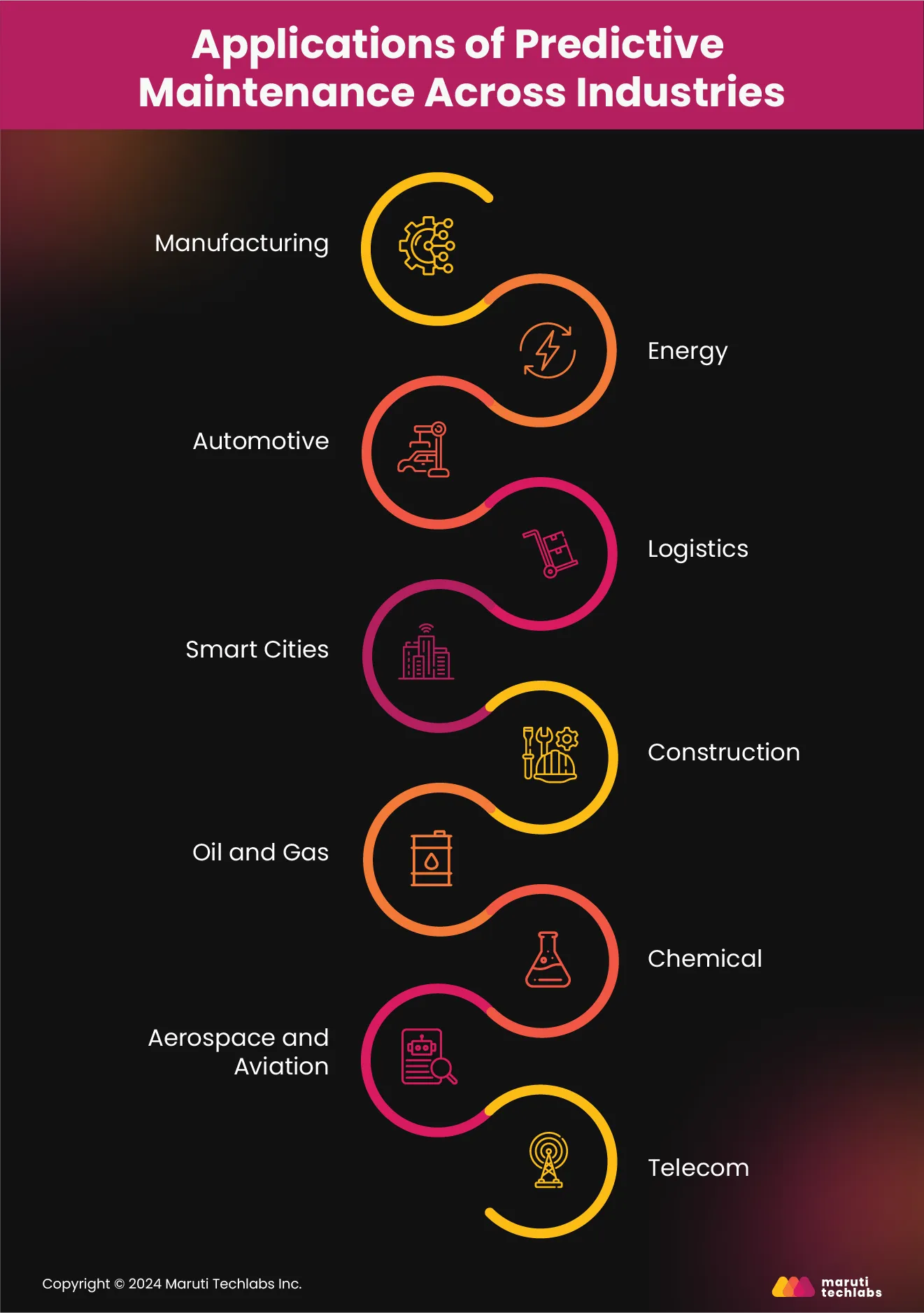

Predictive Maintenance with Machine Learning: Top 10 Applications Across Diverse Industries






Predictive maintenance (PdM) leverages condition-based monitoring to maximize system or equipment performance and lifespan by conducting real-time health assessments. By incorporating sensors, it collects data and applies advanced analytics tools like Machine Learning (ML) to discover and undertake issues as they arise, forecasting future states to reduce risks. A primary deliverable for these systems is to deliver the correct information to the right personnel at the right time.
Predictive maintenance (PdM) uses real-time and historical data from numerous operating facets to foresee and address potential issues proactively.
A predictive maintenance workflow majorly comprises four stages.
Technology and software are the basis of predictive maintenance, especially incorporating artificial intelligence, integrated systems, and IoT. These systems foster data sharing and analysis, offering noteworthy insights by connecting different assets.

Business software like ERM and EAM garner information using industrial controls and sensors. This data is then monitored when engineers upload it on platforms like CMMS. Techniques such as oil and vibration analysis, equipment observation, and thermal imaging are used on areas pinpointed by processed data.
Automated data analysis fosters the prediction of predetermined failure periods of each asset. As opposed to a preventive maintenance strategy that relies on routine repairs and replacements, AI-driven predictive maintenance allows teams to schedule maintenance ahead of time, saving time and resources.
Predictive maintenance applies best to assets, devices, or systems prone to issues due to undeniable circumstances or specific conditions that considerably impact business operations. This results in avoiding the negative impacts by detecting a condition and conducting the required maintenance before a failure happens.
Initial implementation may require effort, but they offer considerable cost savings, a reduction in maintenance costs, and a significant return on investments.

Predictive maintenance models are becoming increasingly popular among various industries. A primary reason for such high adoption is the probability of two scenarios that organizations face concerning maintenance.
The USP with predictive maintenance is that constantly monitoring an asset’s condition and performance allows optimized maintenance to prevent problems.
Here are the most observable benefits of introducing this approach.
All maintenance professionals aim to avoid equipment failures. The sudden machine failure rate can be reduced by almost 50% by regularly checking the condition of equipment and systems.
Condition monitoring strategies allow facility and equipment managers to take necessary steps before an adverse event occurs by inspecting current data about asset health. A predictive maintenance program can eliminate breakdowns by up to 90%.
Reducing machine failures can also significantly reduce the time needed to repair or recondition plant equipment.
Technicians can fix a problem early by observing data from condition monitoring sensors. The mean time to repair can be reduced by up to 60% by leveraging the predictive maintenance model.
The service life of machinery can be increased by almost 30% using AI-driven predictive maintenance that promptly detects problems with equipment or systems.
A damaged, inexpensive part can affect a vital part of the machine, decreasing the asset lifecycle. Post implementation, firms observe a cutdown not only on the severity of damages but also on the rate of defects and deterioration.
Predictive maintenance offers benefits like monitoring sensor data by learning the Mean Time Between Failures (MTBF).
PdM enables maintenance managers to identify the optimal time for machinery replacement, preventing unnecessary and costly maintenance that doesn't enhance the asset's condition.
Using CMMS software, managers can observe when maintenance costs exceed replacement costs to make confident decisions.
Processes such as thermal imaging, vibration analysis, oil analysis, and more can be performed with PdM sensors. They are also used to learn whether a repair was successful before reusing the machine.
It increases efficiency by addressing incomplete or inadequate repairs and eliminating the need for repeated shutdowns.

Predictive technology fosters healthy maintenance of equipment and systems, improving equipment lifespan and reducing unplanned downtime. While this approach bestows many benefits, there are certain drawbacks to consider.
To set up predictive maintenance, one would need significant investments in data analytics software, sensors, and sometimes even IoT. A company implementing this has to incur the first-time cost.
Implementing predictive maintenance requires incorporating numerous systems and technologies, analyzing vast data, and training employees. This learning curve presents various challenges that can be difficult to overcome.
Sometimes, a piece of equipment predicted to be in perfect working condition can be faulty. Over-reliance on predictive data can lead to ignoring evident equipment problems.
Predictive Maintenance | Preventive Maintenance |
|
|
|
|
|
|
|
|
|
|
|
|

Predictive maintenance has much to contribute to manufacturing by optimizing production runs and increasing profits. Therefore, this tech is also leveraged by other industries such as chemical, aerospace, automotive, and more.
Here is a list of industries that have employed predictive maintenance.
Digitization and automation fueled by Industry 4.0 yield ample real-time data for manufacturers. Manufacturers can enhance operational efficiency by using advanced analytics to IoT-based predictive maintenance to develop solutions that integrate seamlessly with MES and production software.
The energy sector traditionally relies on preventive maintenance and is prone to errors. AI-driven predictive maintenance can forecast asset and infrastructure conditions by analyzing real-time and historical data.
Automotive companies use PdM solutions to incorporate condition-based maintenance for factories and post-sales vehicles. Using operational data, they can reduce planning delays, improve maintenance schedules, and use asset insights to ensure workplace safety and avoid downtimes.
With dispersed assets, logistics companies face many challenges in health monitoring. With PdM and IoT, vehicles, warehouses, and distribution centers can enhance asset management by fostering effective maintenance and monitoring in remote locations.
City authorities use reactive maintenance to address annual infrastructure breakdowns disrupting public life. Predictive maintenance with IoT improves efficiency while minimizing disruptions by forecasting issues with water tanks, energy grids, and water tanks.
Significant project delays and capital loss can occur with asset downtimes in construction. PdM assists with this by inspecting site parameters such as temperature and vibration to diagnose faults and prevent disruptions.
These refineries demand a complete operational shutdown to conduct any planned or unplanned maintenance activity due to the hazardous nature of the oil and gas production plants. It can be tackled by employing AI, ML, and predictive analytics that readily identify asset anomalies and minimize resource leakage and capital loss.
Chemical manufacturers have to invest in costly machinery. Untimely and inefficient maintenance can lead to corrosion, failures, or leakages. PdM can help mitigate these issues with proactive interventions.
Aerospace manufacturers leverage PdM for condition-based asset planning and to prevent costly downtimes. Flexible scheduling around worker hours ensures continuous production efficiency by reducing plant stoppages.
The telecommunications sector deploys its assets in remote and inaccessible locations. To combat the challenge of maintenance, these companies employ IoT and PdM. It fosters remote asset monitoring and proactive maintenance planning, eliminating the need for frequent manual inspections.
Type of Data Needed – For this kind of model, both static and historical data are needed. Each and every event needs to be labeled and logged. Numerous events of each type of failure are available in the dataset. This dataset is then used to train the model on how to predict possible failures.
Prerequisites – It is assumed that the static characteristics can be used to predict failure.
The result – This model provides the output in the form of a number of days left before a failure event takes place. This is also known as Remaining Useful Life (RUL).
It can be extremely challenging to create a model that can accurately predict the lifetime of a machine. However, in reality, such a model is not needed. The maintenance team only needs to know if the machine will fail anytime soon. In order to do so, we can use the classification model to predict a failure within the next ’N’ days or cycles (where N = any number).
Type of Data Needed – This model will also require historical and static data. It will also be dependent on labeled and tagged events. As a result, the data characteristics are the same as in Technique 1.
Prerequisites – The prerequisites are very similar to Technique 1. However, there are specific differences as listed below:
Since we are not predicting an exact time and are instead looking for a time frame, the model does not need to assume gradual degradation.
Unlike regression models, classification models can deal with multiple types of failures simultaneously. The only requirement is that the model is framed as a multi-class problem.
Labeled data needs to be available, but in addition, there needs to be sufficient instances of each failure event (and normal event) in order to train the model.
In both the previous techniques, historical data and static data are used to train the model. It helps to understand the relationship between normal time characteristics and failure event characteristics. However, how many failure events is the company willing to digest in order to collect data? In the case of mission-critical systems, failure cases are limited. As a result, a different strategy needs to be adopted.
Type of Data Needed – Both static and historical data are available, but events are not labeled and logged, or they are not available.
Prerequisites – It is assumed that normal behavior can be identified from the data set and the difference between normal and failure event can be distinguished.
In essence, there’s no one-shoe-fits-all strategy here. Each and every project needs to be handled according to the available situation. The first step should be to understand the system, the problems, the available condition surrounding the machine/system and then frame a model in accordance with the required result.
At Maruti Techlabs, we are experienced in advanced predictive modeling and deploying large-scale big data pipelines. With a team of seasoned data science and machine learning professionals – we design, implement and industrialize machine learning and AI based solutions for our clients across a myriad of industries. We amalgamate tech skills with business advice, and assist enterprises in building their own data driven capabilities. Curious about how our artificial intelligence solutions can benefit your business? Feel free to contact us or drop a note on hello@marutitech.com
1. How does predictive maintenance differ from predictive analysis?
The motto behind predictive maintenance or condition-based maintenance is that by frequently inspecting the components of a machine, system, or infrastructure, we can predict potential failures that occur over time. So, one can schedule planned downtimes to repair or service the machine or component in question.
Predictive analytics is a step ahead of PdM. It involves garnering condition-based data over time, employing it with system expertise, and applying machine learning or AI to predict future failures, using comprehensive data and expert knowledge.
2. What is the difference between predictive and preventive maintenance?
Predictive and preventive maintenance have striking similarities, as both strategies aim to perform maintenance before an asset failure can occur. Both assist with decreasing maintenance costs. However, preventive maintenance is more straightforward compared to predictive maintenance.
Predictive maintenance fixes a problem before it manifests into a reality, whereas preventive maintenance follows a schedule. Predictive maintenance maximizes asset use but also requires a skilled team for implementation.
3. Why invest in predictive maintenance techniques?
There are six reasons why one should invest in implementing predictive maintenance techniques.
4. How does predictive maintenance using machine learning impact operational efficiency and cost savings?
Implementing predictive maintenance using AI techs such as machine learning can boost operational efficiency and cost savings in several ways.


